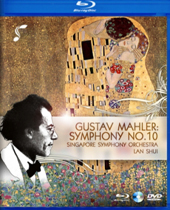
ESSENTIAL RECORDINGS

When, in 1902, Gustav Mahler proclaimed "My Time Will Come!", was he aware of the full potential of that simple
comment. Did he realize, yet alone even dream, that 100 years after his death, his unfinished Symphony No. 10, individually revised and completed by no fewer
than six musicologists/composers over the last 60 years (Carpenter, Wheeler, Wollschläger, Cooke, Mazzetti and Barshai), would be performed, filmed and recorded by the
Singapore Symphony Orchestra in a visually stunning, acoustically perfect, state-of-the-art concert hall, and released on a High-Definition Blu-ray Disc
instantly available anywhere around the world. For the last 50 years, Mahler's music has reached deeper and deeper into the musical fabric of the planet, and has now
attained the highest degree of respect, permanence and acclaim. Talk about prophetic words!
Although the 1960s Deryck Cooke performing version is the most widely recognized and accepted completion of this work, this new recording presents the completed version by
American musicologist Clinton A. Carpenter. It was begun in 1946 and revised many times until being published in 1983, long after Cooke's version had
established its reputation. Both versions share many similarities, but at the same time are also quite different. Cooke glances back to the 19th century for inspiration and
material, whilst Carpenter, taking his cue from the harmonic extremes found in the Mahler completed first movement, looks straight ahead into the 20th century.
The presentation opens with a fly-by bird's eye view of Singapore, with a few close-up shots of the jewel-like Esplanade Concert Hall buildings. Once inside, it is obvious
that the stunning design and in particular the lighting effects allow for visual as well as aural pleasures during a concert. And as soon as the music begins, it is also obvious
that the Singapore Symphony Orchestra is sonically equal to other major ensembles, particularly the string and french horn sections.
Conductor Lan Shui commands a deeply felt account of the opening Adagio movement, exposing the bold harmonic leaps and lush
orchestration. The camera work follows all the action from instrument to instrument very well, and at times pans the beautiful backdrops of the concert hall, ending with
a close-up shot of a bright spotlight during the final moments of the movement, taking its cue from the intense beauty within the music, as the harp ascends, depicting
life affirming energy.
The following Scherzo is given a robust interpretation and clearly defines Carpenter's extended, forward looking development ideas, heavier reliance on wind
instruments in his orchestration, and generally darker outlook. The thematic links are more efficiently worked out and exposed in Carpenter's view, and conductor Lan Shui
brings that well into play.
The short devilish central movement, the pivotal point of the whole work, clearly demonstrates that although remaining true to himself, Mahler was heading into new
directions, made all the more evident in the following fourth movement, where Carpenter's bold orchestration well defines all of the evolving thematic complexities,
abrupt rhythmic changes and challenging harmonic shifts. This is the movement in which Carpenter has added the most of his own material to the music, making it
radically different to Cooke's version. This is Mahler paving the way for future composers. Again the film footage enhances the experience by highlighting the proper
instruments at all the crucial moments.
A drastic difference between versions is the dynamic level of the few blows on the bass drum during the opening page of the final movement. In Cooke's version, they are
loud and riveting, and soft and muffled in Carpenter's. Long and heated debates have taken place to try and explain the difference in approach, but based on how you
perceive Mahler's reasoning behind the use of that bass drum, both versions work just as well. This movement clearly demarks the end of an era and is a touching
epitaph to a way of life. After a beautiful flute and harp melody, the lush strings develop into a force to be reckoned with, all driven along by bold harmonic leaps in
sixths. This all leads to massive chords in the middle of it all, again being given more force by Carpenter's use of percussion. The magic in the writing that follows is
well captured by the conductor and orchestra, with again the strings reaching insurmountable heights, reinforced by Carpenter's heavier use of brass. And in true Mahler
fashion, it all ends with a beauty impossible to describe.
During the round of applause at the end, each section of the orchestra receives well deserved hoots and hollers. The disc includes an interview during which Lan Shui
admits that if it was possible, he would combine various elements from all available versions of Mahler's 10th, to obtain the best of all worlds. But in his opinion,
Carpenter comes closest to what Mahler would have said in the end. He does admit though, that during this performance and recording, he reduced some of the dynamics
of the brass and percussion contrary to Carpenter's indications, to help clarify the lines.
Also included on this recording, is a captivating work by composer Qigang Chen titled Wu Xing (Five Elements), in which by
clever use of all the inherent qualities of various instruments, the composer tries to capture the essence of water, wood, fire, earth and metal. Although structurally
world's apart from the Mahler symphony, it is a fascinating work that brings out this orchestra's many instrumental qualities.
Jean-Yves Duperron - January 2011